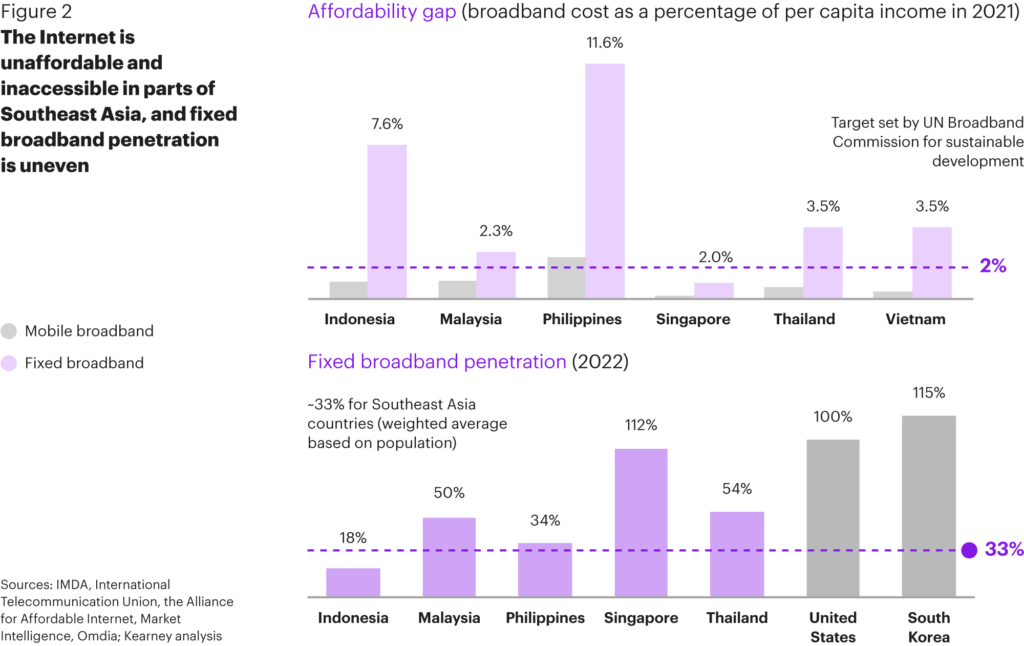
(Source – Shutterstock)
Internet accessibility and affordability still a connectivity hurdle in Southeast Asia
When it comes to internet connectivity in Southeast Asia, there have been many reports showing that some countries in the region offer the best internet capabilities in the world. In fact, statistics show that internet penetration in SEA is as high as 70% in most countries.
Increasing internet penetration has also led to an increase in digital capabilities in the region. For example, the e-commerce market in Southeast Asia is the fastest-growing in the world and is expected to be worth US$1 trillion by 2030, according to a Google report. The data center industry in the region is also booming, with Singapore reportedly having the best connectivity in Asia for data center connectivity.
The expansion of 5G networks is also enabling greater internet accessibility and capabilities. While Singapore already dominates the 5G industry in the region, Indonesia, Vietnam, Thailand, and Malaysia are catching up quickly to gain an advantage in developing more use cases with the technology.
Despite this, a new report from Kearney indicates otherwise. The report, titled ‘Building an Internet for the future of Southeast Asia,’ highlights that while the region’s internet ecosystem is vibrant, governments and businesses must address a host of challenges to make internet accessibility and affordability available to everyone.
Soon Ghee Chua, Senior Partner, Singapore at Kearney and author of the report, commented that the region has undoubtedly achieved great strides in its overall digital economy, as witnessed through the rise in digital consumption and technology adoption rates over the past few years. However, Soon pointed out that there are still roadblocks to making the internet truly inclusive for all consumers with fair returns to all players in the ecosystem.
“As change drivers, governments and business leaders need to proactively address the issues,” said Soon.
The reality is, about 20% of Southeast Asians still do not have internet accessibility. The region also has a long way to go when it comes to the adoption of the next generation of internet connectivity, with 5G penetration rates still below those of developed countries at about 4 or 5%.
Internet affordability is also a major challenge in the region. Currently, the affordability gap for internet services, with fixed broadband prices in Indonesia, the Philippines, Thailand, Vietnam, and Malaysia, does not meet the affordability target of 2% of per capita income set by ITU/UNESCO in 2021.

(Source – Kearney)
To solve this challenge, Kearney has outlined seven fundamental technology trends that leaders should embrace. The top seven trends ranked by industry leaders are cloud computing evolution to the edge, network softwarization, sustainability, application programming interface (API) exposure, network slicing, non-terrestrial network (NTN) convergence, and the management of bifurcation.
Notably, 92% of the region’s tech leaders expect cloud computing evolution to the edge to be a significant technology trend in the next two to three years. Meanwhile, 83% of them expect network softwarization to be a significant one in the next one to three years. This means that internet and network penetration have to reach everyone in the region. Otherwise, it will only lead to a greater digital divide.
Echoing the findings of the report is Singapore’s Deputy Prime Minister Lawrence Wong. In his keynote address at the ATxSG Summit, Wong highlighted that connectivity, cybersecurity, and the responsible use of AI are among the digital priorities that need to be addressed.
In a report by The Straits Times, the deputy prime minister stated that how nations manage these problems will define the future of the digital economy today. For Singapore in particular, Wong mentioned that the island state needs to strive for a digital economy that is trusted, interconnected, and inclusive.

(Source – Asia Tech X Singapore 2023)
To improve Singapore’s network and internet capabilities, the country will look to building hard connectivity infrastructure. This includes new subsea cable landings to increase Singapore’s network capacity, which is one of the goals listed in the Republic’s digital connectivity blueprint. Singapore will also upgrade its networks to raise Internet speeds to 10Gbps, laying the foundation for a new generation of apps.
Wong also highlighted that soft infrastructure like apps that support digital transactions, digital identity, and certification, which form the backbone of today’s digital economy, need to work across borders in order to realize the next bound of digital growth.
“No country can deal with all these issues alone. Only by coming together, and drawing on our collective wisdom and experiences, can we hope to succeed,” the deputy prime minister mentioned at his speech during the opening ceremony of Asia Tech x Singapore (ATxSG).
Carlos Oliver Mosquera, Partner, Singapore at Kearney, Head of Kearney’s Technology Center of Excellence, and author of the report shares similar views on this. Mosquera said, “the future of Southeast Asia’s internet landscape is being reshaped by various global technology trends that are intrinsically linked to the network and connectivity infrastructure. By leveraging trends like edge computing, network cloudification, and network slicing, businesses and governments can deliver more real-time, immersive, and interactive services to end-users.”
READ MORE
- 3 Steps to Successfully Automate Copilot for Microsoft 365 Implementation
- Trustworthy AI – the Promise of Enterprise-Friendly Generative Machine Learning with Dell and NVIDIA
- Strategies for Democratizing GenAI
- The criticality of endpoint management in cybersecurity and operations
- Ethical AI: The renewed importance of safeguarding data and customer privacy in Generative AI applications


